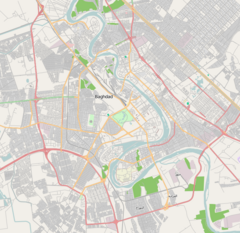Syed Sultan Ali Mosque
| Syed Sultan Ali Mosque | |
|---|---|
Arabic: جامع سيد سلطان علي | |
 The mosque in 1918 | |
| Religion | |
| Affiliation | Sunni Islam |
| Ecclesiastical or organisational status | Mosque and shrine |
| Leadership | Family of Ibrahim al-Rawi |
| Patron | Sayyid Sultan Ali (identity disputed) |
| Status | Active |
| Location | |
| Location | Al-Rasheed Street, Rusafa, Baghdad, Iraq |
Location in Baghdad, Iraq | |
| Geographic coordinates | 33°19′57″N 44°23′54″E / 33.3324°N 44.3983°E |
| Architecture | |
| Type | Mosque |
| Style | Ottoman architecture |
| Specifications | |
| Capacity | 1,000 worshipers |
| Interior area | 600 square metres (6,500 sq ft) |
| Dome(s) | 7 |
| Minaret(s) | 1 |
| Site area | 1,000 square metres (11,000 sq ft) |
| Shrine(s) | 1 |
| Materials | brick |
Syed Sultan Ali Mosque (Arabic: جامع سيد سلطان علي) is a historic mosque in Baghdad, Iraq. It is among the cultural heritages of the city, located at the southern part of the historical area of Al-Rusafa.[1] It is named for Sayyid Sultan Ali, a mysterious figure entombed within the mosque whose identity has been disputed amongst historians. The present mosque is a 16th-century construction.
History[edit]
The exact origins of the mosque are not known. Local folklore and legends cite the origin of the mosque as being formerly being the house of the father (or grandfather) of Ahmad al-Rifa'i, Sayyid Sultan Ali, who was buried in it upon his passing.[2] The Iraqi historian Muhammad Bahjat Athari says that the mosque was built over the grave of Sultan Ali ibn Ismail, the scholarly grandson of Ja'far al-Sadiq.[3][4] The mosque was reconstructed during the Ottoman period by Kemankeş Kara Ali Pasha in the year 1590.[5][6] Then in 1892, Sultan Abdul Hamid II ordered more renovations to the mosque and the establishment of madrasah institutions in there.[1][6] Finally in 2001, the mosque was renovated, and more developments and restorations were ordered by former-Iraqi President Saddam Hussein.[7] The mosque has always been under the management of the family of Ibrahim al-Rawi, a nobleman from the Rifa'i order.[8][3] In 2016, the nobleman Sheikh Abdullah al-Rawi supervised a reopening of the mosque.[5]
Architecture[edit]
The mosque is very large, with the ability to fit more than 1,000 worshippers.[9] It contains a library and a madrasah, where important scholars such as Mahmud al-Alusi taught. The minaret of the mosque is built with brick, in the way of the Ottoman architectural style, while the exterior of it is decorated with blue tiles.[9] The prayer hall of the mosque contains a mihrab and an old minbar.[6][3] The walls of the prayer hall are decorated with calligraphic inscriptions and Qur'anic verses from the inside.[3][5] The mosque also contains a tekke, known as Qara Ali Tekke, and sometimes religious classes were conducted in the Tekke as well.[5]
After the entrance to the mosque, on the left hand side, is the mausoleum of Sayyid Sultan Ali. Next to him is buried the Rifa'i ascetic, Baha al-Din al-Rawas, whose remains were moved here[8] after the original tomb was demolished along with its adjoining mosque. There are also several other tombstones next to Sayyid Sultan Ali's and Al-Rawas' graves. On the right hand side, there is a doorway leading to the Madrasah of Qara Ali.[10] There is also a tomb dedicated to its founder, the Ottoman noblewoman Khatun bint Darwish Jalabi, known as "Qara Ali" by others, located in the middle of the entrance to a corridor of the mosque.[4]
The identity of Sayyid Sultan Ali[edit]
It is commonly believed that the person buried in the mosque, Sayyid Sultan Ali, is the father (or grandfather) of Ahmad al-Rifa'i. The local traditions relate that he came to Baghdad during the rule of Abbasid caliph al-Muhtadi, and when he died, he was buried in his house and the ruler turned the house into a mosque out of respect.[11] Iraqi historian, Muhammad Bahjat Athari, rejects this story, and considers it a fabrication.[5] He instead gives the identity of the entombed as Sultan Ali ibn Ismail, the grandson of Ja'far al-Sadiq. Ottoman scholar, Mahmud Shukri al-Alusi, did not mention the existence of a shrine or even a grave in the mosque despite having wrote a detailed description of it in his book.[5][12] The Qadi, Ala al-Din al-Shukri, writes that the entombed was Sayyid Sultan Ali, a governor of Baghdad.[3]
See also[edit]
References[edit]
- ^ a b الدليل السياحي للأضرحة والمقامات في العراق - دائرة الأضرحة والمقامات والمراقد السنية العامة - ديوان الوقف السني في العراق.
- ^ "جامع سيد سلطان علي - محافظة بغداد". 2020-04-01. Archived from the original on 2020-04-01. Retrieved 2023-12-06.
- ^ a b c d e "جامع سيد سلطان علي في Baghdād". Advisor.Travel (in Arabic). Retrieved 2023-12-06.
- ^ a b "جامع السيد سلطان علي | جريدة الزوراء العراقية". 2018-08-25. Archived from the original on 2018-08-25. Retrieved 2023-12-06.
- ^ a b c d e f "جامع سيد سلطان علي في Baghdād". Advisor.Travel (in Arabic). Retrieved 2023-12-06.
- ^ a b c "جامع السيد سلطان علي | جريدة الزوراء العراقية". 2018-08-25. Archived from the original on 2018-08-25. Retrieved 2023-12-06.
- ^ "أمانة بغداد تستعد لإعادة شارع الرشيد لمكانته التاريخية". www.aljazeera.net (in Arabic). Retrieved 2023-08-17.
- ^ a b "جامع السيد سلطان علي | جريدة الزوراء العراقية". 2018-08-25. Archived from the original on 2018-08-25. Retrieved 2023-12-06.
- ^ a b دليل الجوامع والمساجد التراثية والأثرية - ديوان الوقف السني في العراق. p.36.
- ^ "جامع السيد سلطان علي | جريدة الزوراء العراقية". 2018-08-25. Archived from the original on 2018-08-25. Retrieved 2023-12-06.
- ^ "جامع سيد سلطان علي - محافظة بغداد". 2020-04-01. Archived from the original on 2020-04-01. Retrieved 2023-12-06.
- ^ "جامع السيد سلطان علي | جريدة الزوراء العراقية". 2018-08-25. Archived from the original on 2018-08-25. Retrieved 2023-12-06.


